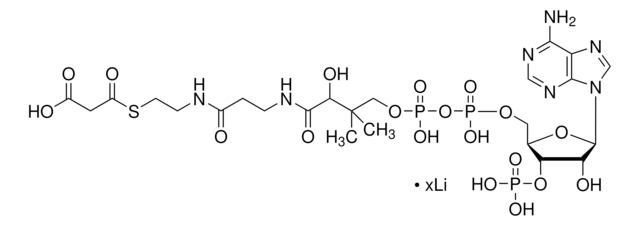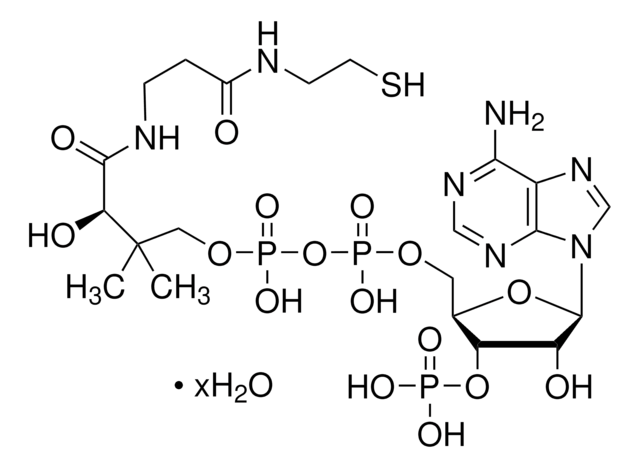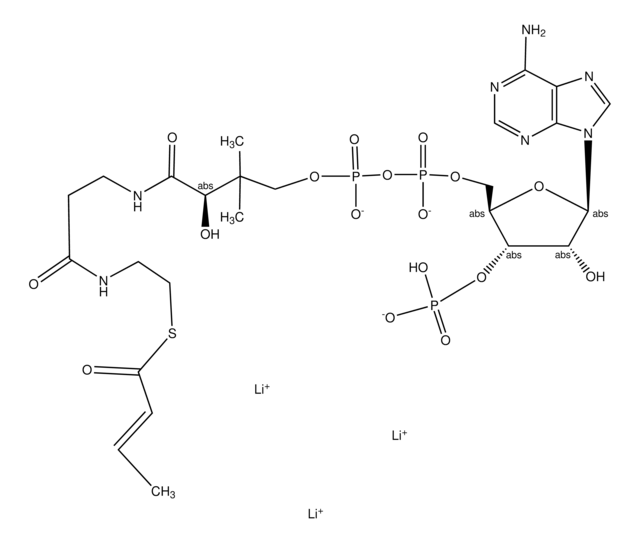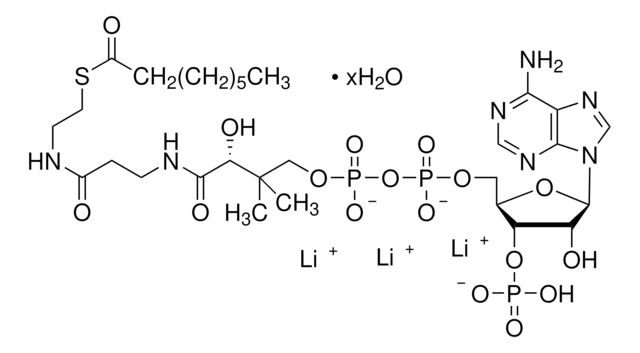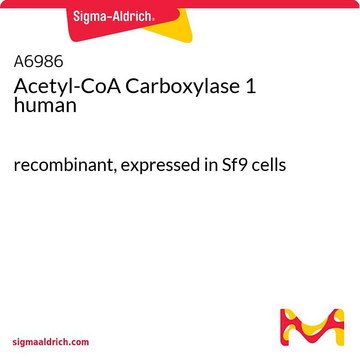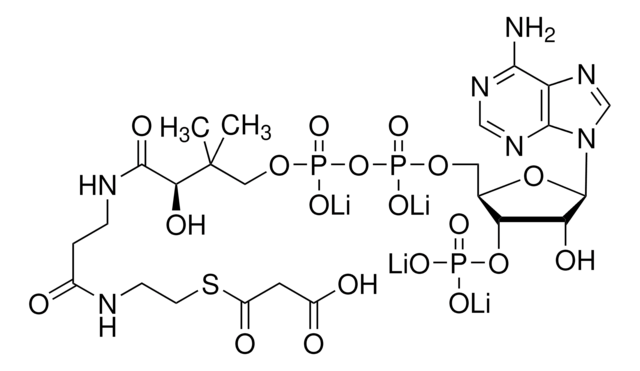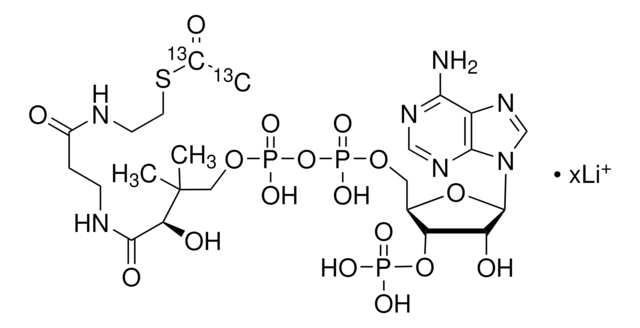Wszystkie zdjęcia(1)
Kluczowe dokumenty
ACOA-RO
Roche
Acetyl-Coenzyme A
85% (Enzymatic and Absorbance), 2% (lithium)
Synonim(y):
Acetyl-Coenzyme A, acetyl-coa
Zaloguj sięWyświetlanie cen organizacyjnych i kontraktowych
About This Item
Kod UNSPSC:
12352204
Polecane produkty
opis
Chemical Formula: C23H35N7O17P3SLi3
Poziom jakości
Próba
85% (Enzymatic and Absorbance)
Formularz
solid
masa cząsteczkowa
Mr 809.6 (acetyl-CoA)
Mr 827.4 (acetyl-CoA-Li3)
opakowanie
pkg of 010 mg (10101893001)
pkg of 200 mg (11585371001)
pkg of 050 mg (10101907001)
producent / nazwa handlowa
Roche
stężenie
2% (lithium)
temp. przechowywania
2-8°C
Opis ogólny
Acetyl-Coenzyme A, trilithium salt
Zastosowanie
Acetyl-Coenzyme A is used to assay CAT enzyme activity in cell extracts using radioisotopes. CAT enzyme activity in cell extracts catalyzes the transfer of acetyl groups from acetylcoenzyme A to chloramphenicol. A number of assays have been developed to measure CAT activity in cell extracts. Acetyl-Coenzyme A has also been used to determine citrate synthase activity.
Działania biochem./fizjol.
Acetyl-Coenzyme A (Ac-CoA) is the end product of glycolysis and takes part in the Ac-CoA pathway, which is a metabolic pathway for carbon compounds. Ac-CoA is important in cholesterol synthesis. It also takes part in fatty acid biosynthesis and catabolism of polyamines like spermine and spermidine. A low level of Ac-CoA leads to a loss in glial cell and neuronal function. Ketone bodies and triglycerides give rise to Ac-CoA on hydrolysis and this indirectly leads to increased histone acetylation.
Uwaga dotycząca przygotowania
Working solution: Optimal solvent: water or aqueous solution with a weak acidic pH (4 to 5).
Storage conditions (working solution): -15 to -25 °C
50 mg/ml in phosphate buffer, pH 7, is stable for 3 weeks at -15 to -25 °C. Unfrozen solutions should be immediately used.
Storage conditions (working solution): -15 to -25 °C
50 mg/ml in phosphate buffer, pH 7, is stable for 3 weeks at -15 to -25 °C. Unfrozen solutions should be immediately used.
Inne uwagi
For life science research only. Not for use in diagnostic procedures.
Ta strona może zawierać tekst przetłumaczony maszynowo.
Kod klasy składowania
11 - Combustible Solids
Klasa zagrożenia wodnego (WGK)
WGK 1
Temperatura zapłonu (°F)
Not applicable
Temperatura zapłonu (°C)
Not applicable
Wybierz jedną z najnowszych wersji:
Masz już ten produkt?
Dokumenty związane z niedawno zakupionymi produktami zostały zamieszczone w Bibliotece dokumentów.
Klienci oglądali również te produkty
L Lu et al.
The Journal of biological chemistry, 271(31), 18920-18924 (1996-08-02)
Polyamine catabolism is rate limited by spermidine/spermine N1-acetyltransferase (SSAT). Although the amino acid sequence of SSAT is known, the substrate binding and catalytic sites are not. The goal of this study was to define the region responsible for acetyl coenzyme
Biochemistry null
Eileen B Ekstrom et al.
Applied and environmental microbiology, 69(9), 5414-5422 (2003-09-06)
Sulfate-reducing bacteria (SRB) in anoxic waters and sediments are the major producers of methylmercury in aquatic systems. Although a considerable amount of work has addressed the environmental factors that control methylmercury formation and the conditions that control bioavailability of inorganic
Short-term variation of nutritive and metabolic parameters in Temora longicornis females (Crustacea, Copepoda) as a response to diet shift and starvation
Tobias Kreibich
Helgoland Marine Research , 62(3), 241-249 (2008)
Agnieszka Jankowska-Kulawy et al.
Neurochemistry international, 57(7), 851-856 (2010-09-21)
Several pathologic conditions are known to cause thiamine deficiency, which induce energy shortages in all tissues, due to impairment of pyruvate decarboxylation. Brain is particularly susceptible to these conditions due to its high rate of glucose to pyruvate-driven energy metabolism.
Nasz zespół naukowców ma doświadczenie we wszystkich obszarach badań, w tym w naukach przyrodniczych, materiałoznawstwie, syntezie chemicznej, chromatografii, analityce i wielu innych dziedzinach.
Skontaktuj się z zespołem ds. pomocy technicznej

